DUCKS AND TOMATOES
/14 Comments/in Fruit, Gardening, Planning, Vegetables/by Lee ReichMy Discerning Ducks
Every morning when I throw open the door to my Duckingham Palace (a name coined by vegetable farmer Elliot Coleman, for his duck house), my four ducks step out, lower their heads as if to reduce air resistance, and race to the persimmon tree. They trace a large circle around the base of the tree, scooping up any fallen persimmons and, still running, gulping them down quickly enough so no other member of the brood snatches it.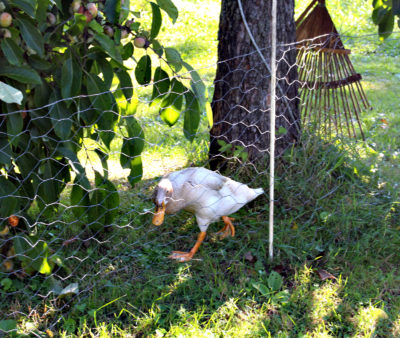
The circle is wide because of the low, temporary fence I’ve set up around the tree. Within the fenced area, I gather up most of the fallen fruit for myself. The ducks, can’t, or haven’t figured out how to, fly over an 18 inch high fence.
My tree is an American persimmon (Diospyros virginiana), native to eastern U.S. from Florida to northern Pennsylvania. Until they are dead ripe, most American persimmons taste awful, with an astringency that dries out your mouth. (As Captain John Smith, of Pocahontas fame, wrote, “When a persimmon is not ripe, it will draw a man’s mouth awrie with much torment.”) Some persimmons never lose that astringency, even when ripe, and here, in the northern reaches of persimmon growing, the season isn’t long enough to ripen most persimmons.
But good persimmons, when ripe, taste like dried apricots that have been soaked in water, dipped in honey, and given a dash of spice. Mine are selected varieties that ripen this far north, the first, Mohler, beginning in early September, and the second, Szukis, beginning in early October. (I grafted both varieties on one tree.) They also set fruit without the need for the separate male pollinator that most American persimmons require.
I highly recommend planting an American persimmon tree. Besides bearing delicious fruit, the tree is attractive all season long and shows off its pretty bark in winter. All this, without the need for spraying or pruning. (I wrote about American persimmon in my book Uncommon Fruits for Every Garden.)
And the Winning Tomatoes Are . . .
As of this writing, tomato plants have not been killed by cold. But with cool weather and disease, they’re pretty much done for the season, bearing few or no fruits. That is, except for Sungold, the most tasty variety of cherry tomato. It just keeps pumping out ropes of orange fruits.
I grew over 20 varieties of tomatoes this year, all heirlooms, except for Sungold. My main criterion for planting any variety is flavor, which was very similar for certain varieties of tomato. They did differ in productivity, my second criterion for choosing a variety. So next year I plan to pare down the number of varieties I grow to the best tasting, most productive ones.
Topping that list will be San Marzano. Right off the plant, eating one is like eating bland cotton. Thrown into pot with a little water to prevent burning and simmered till soft, and the flavor morphs to tart, tomato-y richness. No wonder, canned San Marzano tomatoes are labeled as such in Italy.
Moving on to fresh eating tomatoes . . . Sungold, of course, with eight plants supplying enough for grazing outdoors and salads indoors. Anna Russian, Paul Robeson, and Red Brandywine all have excellent flavor and bore well and late into the season. Anna Russian is also quite good for paste.
Carmello and Valencia are good-tasting tomatoes, although not as good as Anna Russian and company. I’ll grow these two because they’re also very productive, and their fruits are almost perfect spheres. Many heirloom fruits are interesting for their convoluted shapes but sometimes I want just a standard issue, round tomato (that also tastes good).
One more possible variety is from seed a reader sent me a few years ago, a variety labeled Winterkeeper. The fruits allegedly store very well. The plants are still growing well; soon I’ll see how long into fall I’ll be eating tomato sandwiches. Ones I’ve already sampled have pretty good flavor.
Persistent, Young, and Vigorous
Every time I walk back to the compost bin and see the volunteer tomato vine insinuating itself out of a gap in the slats of the bin, I’m reminded of the importance of crop rotation. This vine is still lush and green, and laden with perfect, red, pear-shaped tomatoes.
Sure, the vine could be healthy because its roots are running through the rich, brown compost within the bin. Perhaps the vine is so healthy because, as a random seedling, its genetics, by lucky chance, makes it so.
Most likely, this plant is so healthy and productive because it’s growing where no tomato has grown before. No disease spores linger there from previous crops of tomatoes. (The plant got a late start for the season, so its youthful vigor could also have a hand in its health.) 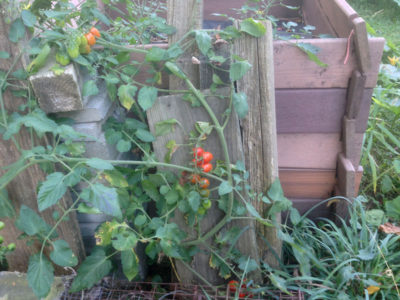
I rotate my tomato beds every year, but that only puts them 10 feet or so from beds of the previous year. That’s the problem with home gardens; it’s hard to get plants far enough away from where they recently were. Thorough cleanup and mulching help, but go only so far.
I have the luxury of two vegetable gardens separated by 50 feet of lawn, one of which hasn’t been home to tomatoes for over a year. Next year it will be.
The flavor of the compost-grown tomato? Good enough, not great.
THE WEATHER, AND BLACKCAPS
/0 Comments/in Fruit, Gardening, Planning, Soil, Vegetables/by Lee ReichDry Soil
Digging a hole to bury an animal last week gave me new respect for the plant world. Each shovelful brought up dusty, light brown soil, even to a depth of more than two feet. That’s expected, since it hasn’t rained more than 1/4 of an inch here for the past five weeks.
With their leaves flagging in midday, trees and shrubs don’t exactly look spry. Still, they are alive, even some spring-planted trees and shrubs which have had little time to spread their roots deep and wide.
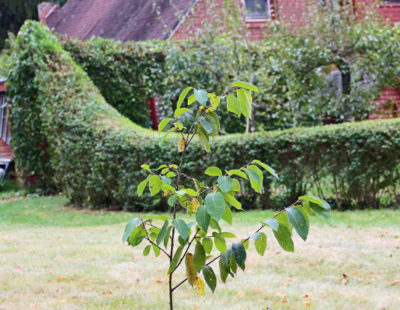
Thirsty, young Asian persimmon
Appearance of a soil can be deceiving. There’s some water lurking within those pores, water held tightly by capillary attraction. After heavy rains or irrigation, all soil pores get filled with water, a situation as bad for plants, if it lasts too long, as dry soil. Plant roots need air as well as moisture; air gets sucked in once gravity drains water from the largest soil pores.
From then on, capillary attraction is what holds moisture in the ground — a pleasant situation for plants because the roots can tap into the more loosely held capillary water while they breathe freely. I prepare for possible droughts when planting by digging relatively small planting holes, which minimizes the amount of ground loosened up, in turn, among other benefits, preserving capillary networks in the soil. (Mulching and watering, right after planting, also helps.)
Eventually, more and more of the loosely held capillary moisture gets sucked out of the ground by plants and evaporation. At some point, there’s still moisture in the soil, but what’s left is in the smallest pores and right against soil particles. It’s tightly held capillary moisture, water that plants can’t access. They wilt. When moisture levels drop to what’s known as the “permanent wilting point,” plants die.
We’re not there yet and now, toward the end of the season, woody plants do have a Plan B: They can just drop their leaves, reducing moisture loss from stems and roots, and segue into winter on stored energy and moisture. To a point.
Cold Air
If it’s not one thing, weather-wise, it’s another. On September 26th, I woke to find parts of the lawn hoary with frost. I’m not complaining. Frost should be expected, on average, around that date around here. Except that I’ve been spoiled for the last few years by much later frosts, frosts, so late that I pulled out old tomato plants because chilly weather drained tomatoes of their flavor rather than frosty weather killing the plants.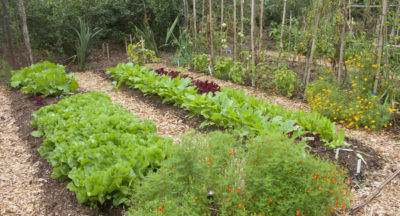
Also, no complaints because the September 26th brought only a light frost; temperatures just hit 32°F. and the hoariness was spotty, here and there. A light frost is a good thing this time of year. It signals plants to get ready for even colder weather. In preparing for cold, cell walls strengthen and permeability of cells to water is actively altered. Even subtropical plants like peppers and tomatoes toughen up, with some chilly preparation, so that they can now tolerate temperatures that drop even a few degrees below freezing.
Tender vegetables, frost or no frost, on the wane, have left the door open to vegetables that enjoy the cool weather of autumn. Most of the garden now presents a verdant sight of beds lush with lettuce, Chinese cabbages, winter radishes, endive, turnips, cabbages, arugula, mustard greens, carrot tops, and leeks, all ready for harvest, at my leisure, over the next few weeks.
Fall Black Raspberries
Segueing over to the fruit world, I’m still harvesting the last of the blackcaps (black raspberries) of the season. Blackcaps? Anyone familiar with this fruit, abundant in the wild and often cultivated, knows that they ripen in midsummer.
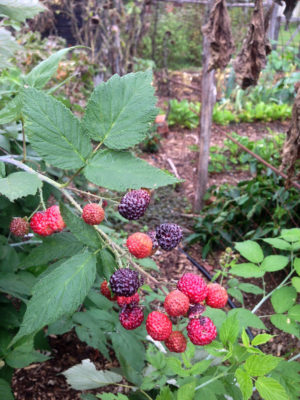
Niwot blackcap, now ripe
Last year I planted two new varieties of blackcap, Niwot and Ohio’s Treasure. With most blackcaps, canes just grow their first year, then fruit their second year. (During the second year, new canes are also growing, to fruit the following year, so a planting bears fruit every year.) Niwot and Ohio’s Treasure bear fruit at the end of the canes’ first year of growth, in late summer and autumn. Those same canes — I think — then continue bearing the following year, in summer, just like most blackcaps.
I haven’t yet decided whether Ohio’s Treasure or Niwot offer the better berry, but it’s nice to be harvesting fresh berries this late in the season.
GOOD FOR CROPS, GOOD FOR THE EARTH
/13 Comments/in Gardening, Soil/by Lee ReichHow to be a Good Gardener/Farmer, Simplified
“The poor farmer grows weeds, the mediorcre farmer grows crops, the good farmer grows soil.” How true, when I think of the good farmers and gardeners I’ve visited over the years. I aspire to be a good farmdener and spend a lot of time trying to grow soil.
Growing soil isn’t all that complicated. (You do need to start with good drainage of water.)
First, keep the ground covered. Organic mulches, such as leaves, straw, and wood shavings, keep rain from pounding the surface. The pounding drives small soil particles into pores, sealing the soil surface so water can’t percolate in. Bacteria, fungi, worms, and other soil organisms gobble up organic mulches, releasing nutrients and forming humus, which improves percolation and moisture retention, and makes room also for air in the soil. In my gardens, I never want to see bare ground.
Live plants likewise protect the ground. The plants might be cabbages, marigolds, carrots, and other garden plants. They might be cover crops, such as rye, oats, peas, or buckwheat, sown specifically to clothe and protect the ground during or at the end of the growing season, and through winter. They might even be weeds — Mother Nature’s way of protecting her soil.
Second, maintain soil organic matter. Mulches do this, as do growing plants. I go one step further, and import organic matter. Bushel after bushel of leaves that have been raked and bagged by neighbors are collected are unbagged and unraked once they arrive here. Leaves that have been vacuumed into a landscaper’s large truck and then left here in a pile get unpiled here one pitchfork and garden cart at a time.
I also pitchfork horse manure into the bed of my pickup truck at a local stable. Mostly, that manure is transmuted into compost and then slathered onto beds in the vegetable garden.
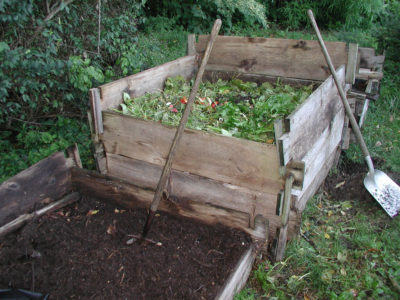
Compost, in the making
I also import — really just transfer — some organic material from one part of my property to another. My small hayfield gets mowed once a year by tractor to keep it from becoming forest but parts of it I periodically scythe, these mowings to feed, along with the horse manure (and kitchen waste, old garden plants, etc.), compost piles.
The third key to growing soil is to maintain fertility. A soil test can confirm what, if anything, is needed. If the first and second points in growing soil are followed, fertility is probably up to snuff.
And finally, the fourth key to growing soil: Minimize soil disturbance, avoiding tillage or, at least, excessive tillage. Tillage mixes so much oxygen into the ground that soil organisms go into a feeding frenzy, in so doing gobbling up organic matter too fast. Thus, many of the above benefits, physical, biological, and nutritional, waft away, literally, as carbon dioxide.
Farming and gardening aren’t “natural.” At their best, they are a balancing act that leans towards emulating natural systems. Which is to say, for instance, that tillage, is not all bad; it can be part of good soil growing if not done to excess and points one, two, and three are followed.
A measure of “organic matter content” (OMC), from a soil test, provides a rough indication of soil growing progress. Less than 3% means more work is needed. Five percent, or more, is very good. (My vegetable beds are at about 15%.)
Blue-Green Algae Redux
Last week’s notes about the darker side — and the brighter side — of blue-green algae may have left everyone feeling helpless. After all, you can’t change the hot dry weather that is, in part, responsible for the current blooms. But nitrogen, phosphorus, and other minerals washing into waterways to feed the bacteria also play a role, and it’s something over which we have control.
Improper septic systems are one culprit.
More topical culprits are mineral nutrients originating in backyards and farm fields. Too many farmers and homeowners subscribe to the philosophy that “if a little is good, more is better,” when it comes to fertilizer. Not so. Too much fertilizer not only is a waste of money; it damages or kills plants and, with rain, leaches through or runs off the soil to eventually find its way into waterways. A soil test will tell what nutrients, if any, are needed.
Even better, if fertilizer is needed, is to use an organic fertilizer. Most are not water soluble until metabolized by soil organisms, which means they are less likely to wash through the soil.
Better still would be to use compost to provide fertility. Nutrients in compost are locked up physically and chemically, waiting to be released by soil life in synch with plant uptake and growth.
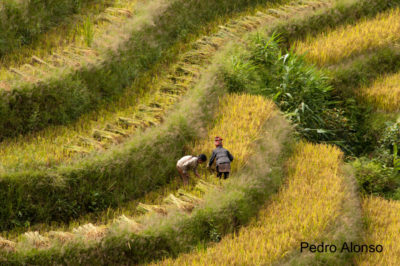
Terraced field in Viet Nam
Phosphorus is a plant nutrient that binds tightly to soil granules, but makes its way downhill when rain washes over bare soil to move it downslope. One way to keep this nutrient out of waterways is to keep the soil covered with mulch or vegetation, especially on sloping land. Another way is to avoid exposing soil by tillage. Another way, if tillage is needed, is to till perpendicularly to the fall line of a slope. And yet another way is to alternate tilled areas with grassy strips to catch and hold soil.
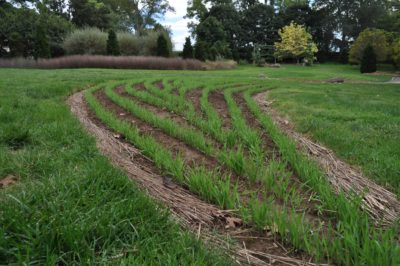
Rye cover crop
Do a lot of these recommendations — mulches, cover crops, composts, no-till — for preventing blue-green algae blooms sound familiar? Good gardening and farming practices are also good for the environment.

